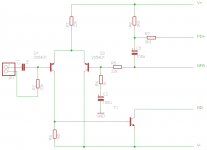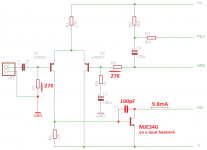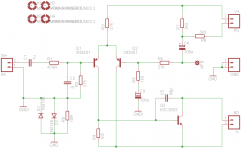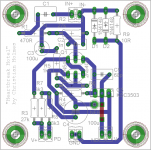Super Simple IPS?
I've been following this thread since the start. I'm still putting the finishing touches on my own CFA-XH + SlewMonster, and look forward to hearing it first-hand. From what Terry has said, it seems that all these IPS are "state of the art" and so highly polished that they all sound the same.
Has anyone thought about going the other way and bolting a simple IPS to the SlewMonster just to find out whether there is any sonic deficiency (or superiority) to these complex designs?
My own humble submission:
I've been following this thread since the start. I'm still putting the finishing touches on my own CFA-XH + SlewMonster, and look forward to hearing it first-hand. From what Terry has said, it seems that all these IPS are "state of the art" and so highly polished that they all sound the same.
Has anyone thought about going the other way and bolting a simple IPS to the SlewMonster just to find out whether there is any sonic deficiency (or superiority) to these complex designs?
My own humble submission:
Attachments
I've been following this thread since the start. I'm still putting the finishing touches on my own CFA-XH + SlewMonster, and look forward to hearing it first-hand. From what Terry has said, it seems that all these IPS are "state of the art" and so highly polished that they all sound the same.
Has anyone thought about going the other way and bolting a simple IPS to the SlewMonster just to find out whether there is any sonic deficiency (or superiority) to these complex designs?
My own humble submission:
He,he, you have some boards now. You could be the first to try your IPS. I did use the front end of the VSSA as well as the front end of a Symasym to try out the OPS before we had any of OS's IPS ready. They were difficult to set up because neither were designed to run on high voltage. It was a fun challenge.
I plan to do precisely that, Terry. While you guys take OStripper's high road, I'll take the low road (and have CFA-XH, Valery's Hybrid as point of comparison) with this super-simple, technically flawed 3 stage Lin 🙂
Cool!!! I can't wait to hear your impressions. I love the idea of simplifying the IPS. If it works I may try it myself. Looks like it could be built fairly easily on a perf-board.
If you follow the final modifications Valery made to the hybrid it will work well. I plan to hook it up to the SlewMOSFET OPS in the next couple of days just to see If I can hear anything new. I had ordered some 500R trimmers and should receive them any day now. I may wait and install them before I do any more testing. Some IPS need a little bias adjustment. I don't remember if the hybrid was one of them.
Fun Stuff!!!!!!
If you follow the final modifications Valery made to the hybrid it will work well. I plan to hook it up to the SlewMOSFET OPS in the next couple of days just to see If I can hear anything new. I had ordered some 500R trimmers and should receive them any day now. I may wait and install them before I do any more testing. Some IPS need a little bias adjustment. I don't remember if the hybrid was one of them.
Fun Stuff!!!!!!
I've been following this thread since the start. I'm still putting the finishing touches on my own CFA-XH + SlewMonster, and look forward to hearing it first-hand. From what Terry has said, it seems that all these IPS are "state of the art" and so highly polished that they all sound the same.
Has anyone thought about going the other way and bolting a simple IPS to the SlewMonster just to find out whether there is any sonic deficiency (or superiority) to these complex designs?
My own humble submission:
Hi Ranchu,
This is going to be fun!
May I suggest couple of things.
R5 (and R2 respectively) - 27K will make overall gain closer to the "standard" 29db.
Miller cap is a must here, otherwise it's going be a "screaming oscillator" 🙂
OPS will require re-biasing, comparing to most IPSs we use here, because of the higher VAS current. VAS is going to run pretty hot, but still acceptable (with a local heatsink).
I ran a couple of simple simulations (with SlewMonster OPS attached) - it shows 0.029% THD @ 1KHz and 0.76% THD @ 20 KHz.
It's funny THD does not change in a wide range of OPS quiescent currents - meaning, OPS's portion of distortion is negligible here 🙂
It will be very interesting to hear how different it will be, sonic-wise.
I think I'm also going to test it 😉
Let's add some distorrrrrrtion!

Terry, I think in your well-organized AB testing environment it would be really interesting as well, BTW 🙄
Cheers,
Valery
Attachments
Last edited:
I tried to sim that but couldn't get it to work. When I'm back at my computer I will try again. I may just try to build it. I have a light bulb.😀
I want to add that the LP filter is part of the input impedance, as well as the local decoupling of the input transistor. So this also falls within the scope of a standard input impedance. If you don't have a standard LP filter, you can't have a standard input impedance.
For those for who experience the input cable and LP filter to have an important effect, I recommend using an RC terminator on the cable (75R+220p or so), because RFI from cable reflection-resonances can cause exaggerated differences between different cable and input impedances.
For those for who experience the input cable and LP filter to have an important effect, I recommend using an RC terminator on the cable (75R+220p or so), because RFI from cable reflection-resonances can cause exaggerated differences between different cable and input impedances.
Miller cap is a must here, otherwise it's going be a "screaming oscillator" 🙂
Maybe, if the VAS doesn't already have enough Cob. Sometimes Cob is actually MORE than you need, so the HF THD is limited not by the miller cap, but by the VAS transistor you use.
Yes, the THD comes from a stage before the OPS, the Early effect and Cob of the VAS, and thus is a load-independent signal distortion - as if you had a harmonic effect in front of the amp but after the volume control. The OPS distortion is still present, just swamped by the enormous VAS distortion.It's funny THD does not change in a wide range of OPS quiescent currents - meaning, OPS's portion of distortion is negligible here 🙂
Maybe, if the VAS doesn't already have enough Cob. Sometimes Cob is actually MORE than you need, so the HF THD is limited not by the miller cap, but by the VAS transistor you use.
In simulation it oscillated violently - phase responce is very bad with no miller.
Yes, the THD comes from a stage before the OPS, the Early effect and Cob of the VAS, and thus is a load-independent signal distortion - as if you had a harmonic effect in front of the amp but after the volume control. The OPS distortion is still present, just swamped by the enormous VAS distortion.
Yep, that's what I mean )
And that's exactly what we need to prove we can hear the difference... or we can't 😀 I hope we can 😛
Cheers,
Valery
Argh! I forgot the miller cap, that's what happens when trying to knock together this schematic in 5 mins flat! I have had very good results with the KSC3503 in the VAS position, and with this topology and VAS transistor we can safely drop down to 68p.
Have we standardised on the gain and LP, HP filters for the IPS? I think that is a very good idea from a comparison point of view. I will add the extra R and C to the front end if someone can tell me the fc points.
Have we standardised on the gain and LP, HP filters for the IPS? I think that is a very good idea from a comparison point of view. I will add the extra R and C to the front end if someone can tell me the fc points.
I'd say set the input LP filter to 30-50KHz. Ultrasonic signals can cause intermodulation in some speakers if not in your amp. The trick is to do this without using a large input resistor, which can degrade the IPS. 470R seems like a good value to me.
One test I like to do to ascertain ultrasonic resilience of an amp is to add a 5mV pk-pk 100KHz triangle wave (common with SMPS) to the input signal and see whether the distortion rises. Some otherwise superb amplifiers fail alarmingly on this test. If so, then it will require a LP filter that will remove ultrasonic signals.
One test I like to do to ascertain ultrasonic resilience of an amp is to add a 5mV pk-pk 100KHz triangle wave (common with SMPS) to the input signal and see whether the distortion rises. Some otherwise superb amplifiers fail alarmingly on this test. If so, then it will require a LP filter that will remove ultrasonic signals.
Hi Kean, I usually set the cutoff frequency to a decade away fro the audible band. A 470R and 1n is in the ballpark. Quality np0 ceramics in this value are plentiful and low cost. Good enough?
At 200KHz you're not filtering any SMPS noise or ultrasonics, but this is still generally accepted as okay. If intermodulation occurs in the speakers it will occur no matter which amp you use, so I guess explicitly for comparisons, there is no need to filter ultrasonics.
Heartbreak Hotel
Hi guys, I bring you "Heartbreak Hotel", named after the popular Elvis song recorded the same year Harry C. Lin devised the topology this design is based upon.
I've laid this out with all through-hole parts, single-sided, in case anyone cares to build it.
I note that OStripper's input stages all feature a ground lift, so I've followed suit in case noisy grounding implementations put this one at a disadvantage... 😉
Valery, if you still have this in Spice, and have the inclination, perhaps you could calculate the currents in the LTP collectors so we can optimise R4.
Hi guys, I bring you "Heartbreak Hotel", named after the popular Elvis song recorded the same year Harry C. Lin devised the topology this design is based upon.
I've laid this out with all through-hole parts, single-sided, in case anyone cares to build it.
I note that OStripper's input stages all feature a ground lift, so I've followed suit in case noisy grounding implementations put this one at a disadvantage... 😉
Valery, if you still have this in Spice, and have the inclination, perhaps you could calculate the currents in the LTP collectors so we can optimise R4.
Attachments
Last edited:
Hi guys, I bring you "Heartbreak Hotel", named after the popular Elvis song recorded the same year Harry C. Lin devised the topology this design is based upon.
I've laid this out with all through-hole parts, single-sided, in case anyone cares to build it.
I note that OStripper's input stages all feature a ground lift, so I've followed suit in case noisy grounding implementations put this one at a disadvantage... 😉
Valery, if you still have this in Spice, and have the inclination, perhaps you could calculate the currents in the LTP collectors so we can optimise R4.
Yes, in fact the optimal value for R4 is 510R. LTP is the most balanced in this case.
But in this case, THD20 is reduced to 0.042%, making the distortion much less distinguishable... It becomes too good 😀
One more thing - let's turn Q3 90 degrees CCW, making more space for a heatsink 😉
Just thought - at VAS current close to 10mA, it will easily drive couple of laterals, connected directly to it, giving us another "very simple" one "in a matchbox" 😛
- Home
- Amplifiers
- Solid State
- Slewmaster - CFA vs. VFA "Rumble"



